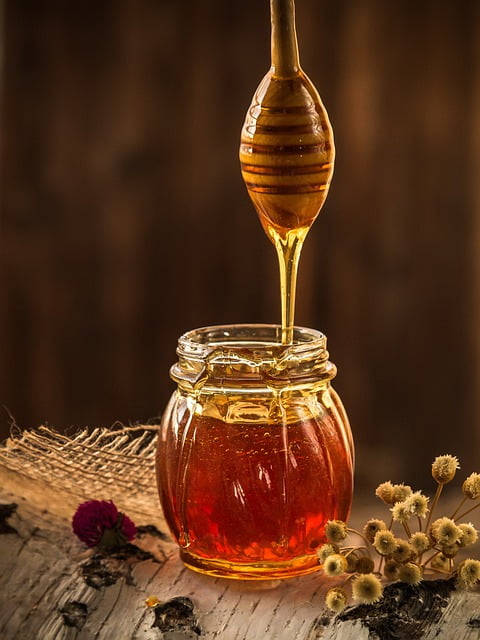Honey is a natural sweet substance produced by bees, primarily honey bees, from the nectar of flowers. Bees collect nectar, a sugary liquid, and transform it into honey through a series of processes within their hive.

Honey is stored in hexagonal wax cells in the beehive, where it serves as the primary carbohydrate source for the bee colony.
It is known for its distinct sweet taste, but it also has a complex chemical composition, including natural sugars (such as glucose and fructose), enzymes, antioxidants, and trace amounts of various vitamins and minerals.

Honey’s low moisture content and acidic pH make it an inhospitable environment for microorganisms, giving it a long shelf life without the need for refrigeration.

The process from bees to honey involves these :-
Nectar Collection: Bees collect nectar from flowers using their long, tube-like mouthparts (proboscis). Nectar is a sugary liquid produced by flowers to attract pollinators. Bees ingest the nectar from flowers.
Nectar Transformation: Once back in the hive, bees regurgitate the nectar into the mouths of other worker bees, who further process it.

During this process, enzymes are added to the nectar, which help break down the complex sugars in the nectar into simpler sugars, primarily glucose and fructose.
Evaporation: Worker bees then fan their wings to create air circulation within the hive. This airflow helps evaporate the water content in the nectar, reducing it to about 17-20%, which is much lower than the water content in nectar.

Ripening into Honey: The transformed and evaporated nectar is then deposited into honeycomb cells and sealed with a wax capping. The concentrated sugar content and low moisture level in the sealed cells make it difficult for microorganisms to thrive, preserving the honey.

Honey is not only valued for its culinary uses but also for its potential health benefits, which include soothing sore throats and coughs, acting as a natural sweetener, and providing antioxidants.

Different types of honey can be found, each with unique flavours and characteristics, depending on the types of flowers the bees visited to collect nectar.

Does honey expiry? Natural, properly preserved honey will not expire. Archeologists found honey thousands of years old in ancient Egyptian tombs, and it was still good.
While most of us don’t need to worry about honey that old, their discovery proves that if properly contained, real honey can last for a very, very long time.

Honey is a versatile and delicious natural sweetener that can be enjoyed in various ways. What’s your honey-harmony secret? How do you prefer to indulge in this liquid gold?

As a Sweetener: Honey can be used to sweeten a wide range of foods and beverages, such as tea, coffee, and cereal. On Toast or Bread: Spread honey on toast or bread for a sweet and flavourful topping.

Honey can be used in cooking and baking to add sweetness and flavour to a variety of dishes, including marinades, dressings, and desserts.
With Yogurt or Oatmeal: Drizzle honey over yogurt, oatmeal, or other breakfast dishes for added sweetness and flavour.

As a Dip: Honey pairs well with cheese, fruits, and crackers and can be used as a dip or drizzle.
For Health: Some people consume honey for its potential health benefits, such as soothing a sore throat or as a natural remedy for various ailments.

Are you a honey aficionado? Share your favourite honey-inspired delights and how you like to savour the liquid gold!
Keep your taste buds tingling in anticipation for our upcoming post on delightful ways to savor honey and mouthwatering recipes!

[…] on the ice cream train? Dive into our sweet world of honey for a delectable […]
[…] you enjoy pairing your tea with honey? Share your thoughts in the comment, and let us know how you prefer to savour your favourite […]